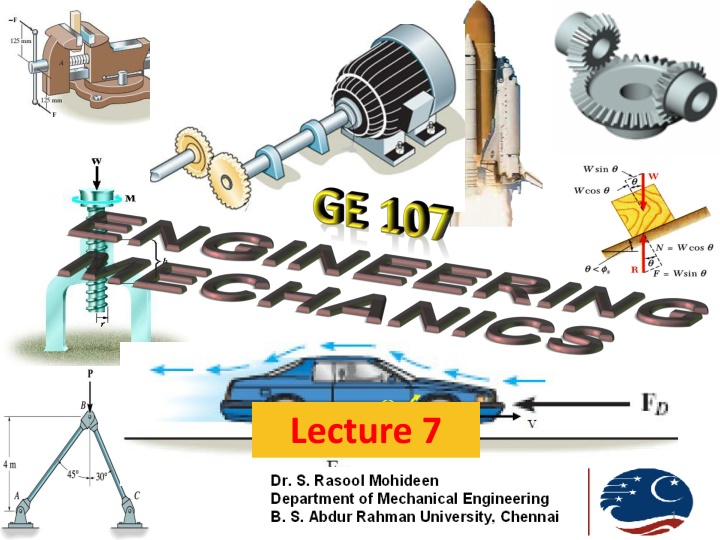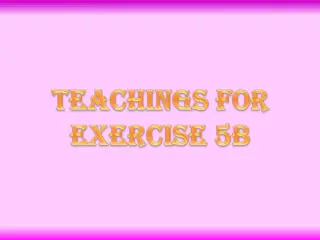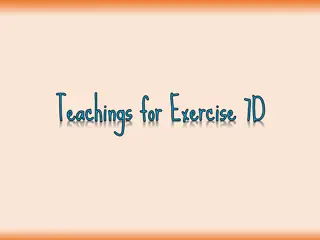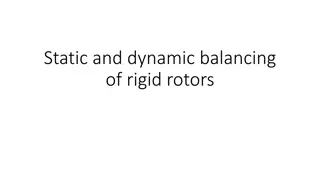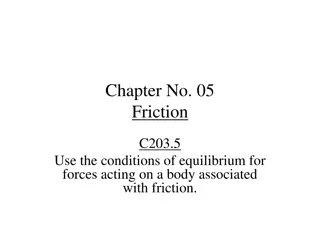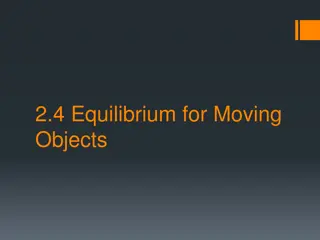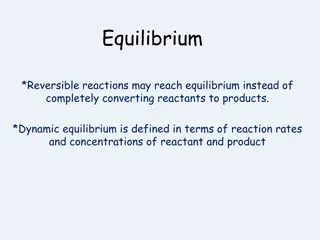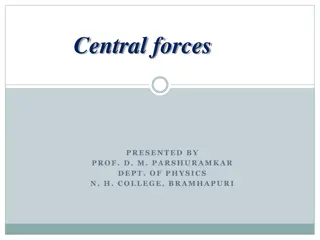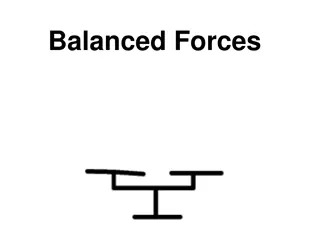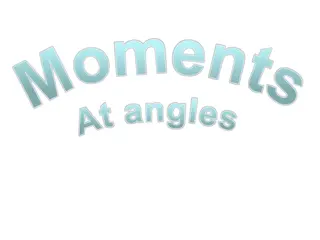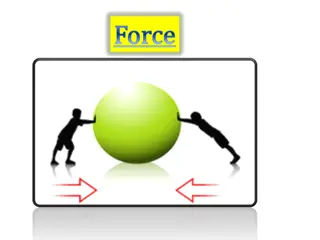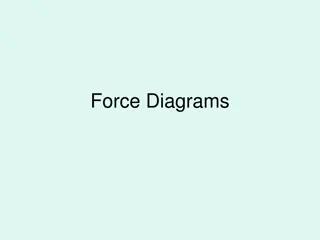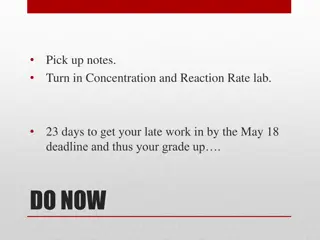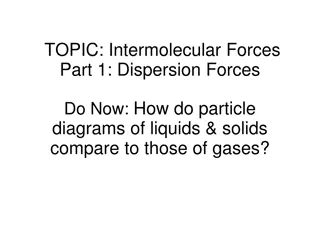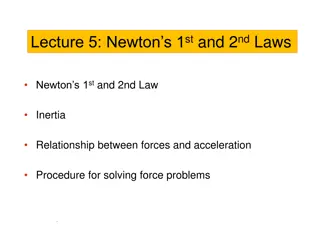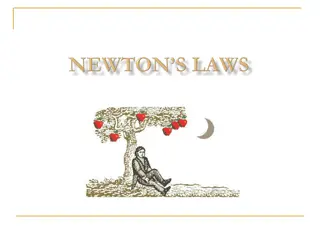Equilibrium of Rigid Bodies: Moments, Couples, and Forces
The topic covers the equilibrium of rigid bodies with a focus on moments, couples, and forces. It discusses concepts such as moments of a force, Varignon's theorem, types of supports, and equilibrium in two and three dimensions. The equilibrium in two-force members and three-force members is explained, along with examples demonstrating these principles.
Download Presentation

Please find below an Image/Link to download the presentation.
The content on the website is provided AS IS for your information and personal use only. It may not be sold, licensed, or shared on other websites without obtaining consent from the author.If you encounter any issues during the download, it is possible that the publisher has removed the file from their server.
You are allowed to download the files provided on this website for personal or commercial use, subject to the condition that they are used lawfully. All files are the property of their respective owners.
The content on the website is provided AS IS for your information and personal use only. It may not be sold, licensed, or shared on other websites without obtaining consent from the author.
E N D
Presentation Transcript
UNIT II EQUILIBRIUM OF RIGID BODIES SYLLABUS 2 Moments and Couples Moment of a force about a point and about an axis Vectorial representation of moments and couples Scalar components of a moment Varignon s theorem Free body diagram Types of supports and their reactions requirements of stable equilibrium Equilibrium of Rigid bodies in two dimensions Equilibrium of Rigid bodies in three dimensions Examples
Equilibrium in Two Force Members As the name implies. A two force member has forces applied at only two points on the member. An example of a two force member is shown in Figure a To satisfy force equilibrium. FA and FB must be equal in magnitude. FA = FB = F, but opposite in direction as in Figure b. Moment equilibrium requires that FA and FB should have the same line of action,( M=MA = MB =0) which can only happen if they are directed along the line joining points A and as shown in Figure c 3
Equilibrium in Two Force Members (Contd..) Hence for any two-force member to be in equilibrium, the two forces acting on the member Must have same magnitude Opposite in direction Acting on the same line of action Directed along the line connecting two points where the two forces are applied. 4
Equilibrium in Three Force Members The member are subjected to only three forces Moment equilibrium can be satisfied only if the three forces form a concurrent or parallel force system For example, consider the member subjected to the three forces as shown in Figure a the lines of action of F1 and F2intersect at point D. Then the line of action of F3 must also pass through point D so that the forces satisfy Mo = O. As a special case, if the three forces are all parallel as in Figure b, the location of the point of intersection D will approach infinity. 5
6 Example The lever ABC is pin supported at A and connected to a short link BD as shown in Figure. If the weight of the members is negligible, determine the force of the pin on the lever at A.
7 Example(Contd.) Free -Body Diagrams for the given lever setup is to be drawn As shown in Fig. b, the short link BD is a two force member. Hence the forces at pins D and B must be equal. opposite. and collinear. Although the magnitude of the force is unknown. the line of action is known since it passes through B and D. For the lever ABC, as it is is three force member,, the three nonparallel forces acting on it must be concurrent.
8 Example(Contd.)
9 Problem 1 A man raises a 10-kg joist, of length 4 m, by pulling on a rope. Find the tension T in the rope and the reaction at A.
10 Solution to Problem 1 Free-Body Diagram The joist is a three-force body, since it is acted upon by three forces: weight W, the force T exerted by the rope, And its reaction R of the ground at A The joist is a three force body and hence the forces should be concurrent for equilibrium The reaction R, therefore, will pass through the point of intersection C of the lines of action of the weight W and the tension force T.
11 Solution to Problem 1 (Contd.) Drawing the vertical BF through B and the horizontal CD through C, we note that The direction of force R can be thus found as
12 Solution to Problem 1 (Contd.) A force triangle is drawn as shown, and its interior angles are computed from the known directions of the forces. Using the sine rule,
13 Problem 2 A skeletal diagram of a hand holding a load is shown in the figure. If the load and the forearm have masses of 2 kg and 1.2 kg respectively. and their centre of mass are located at G1and G2, determine the force developed in the biceps CD and the horizontal and vertical components of reaction at the elbow joint B. The forearm supporting system can be modeled as the structural system shown
Equilibrium of a rigid body in three dimensions A body in a 3D space will have six degrees of freedom Hence six scalar equations are required to express the conditions for the equilibrium of a rigid body in the general three-dimension 14 The above scalar equations will be more conveniently obtained if we first express in vector form These equations can be solved for no more than six unknowns, which generally will represent reactions at supports or connections.
15 Support Reactions in 3D
FBD in 3D Y Z Z Z FZ MZ FZ MZ Y MY MY Y FY FY X Find the constraint forces and moments for the given assembly and show them in the FBD X FX FX X FBD of 1 FBD of 2 As the shaft system is free to move in one direction only (rotate around X), it has five constraints namely Fx, Fy, Fz, MZ and My.
Exercises Problem 1 Problem 2 Problem 3 Problem 4
18 Example Determine the components of reaction that the ball and socket joint at A, the smooth journal bearing at B and the roller support at C exert on the rod assembly as shown in Figure
19 Example (Contd.) As shown on the free-body diagram, the reactive forces of the supports will prevent the assembly from rotating about each coordinate axis and the journal bearing only exerts reactive forces on the member. Equations of Equilibrium can be used to solve the unknowns The force Ay obtained by summing forces along the y axis. The force FC can be determined directly by summing up moments about the y axis.
20 Example (Contd.) Using this results , reaction BZ can be determined by summing up the moments about x axis. The negative sign indicates that B, acts downward. The force BX can bee found by summing moments about thezaxis.
21 Problem 3 Rod AB shown in Fig.(a) is subjected to the 200 N force. Determine the reactions at the ball-and- socket joint A and the tension in the cables BD and BE.
22 Solution to Problem 3 Free-Body Diagram is shown in Fig.(b) Representing each force on the free-body diagram in Cartesian vector form, Applying the force equation of equilibrium,
Solution to Problem 3 (Contd.) Summing up moments about point A yields, 23 Expanding and arranging the terms Solving the above equations
